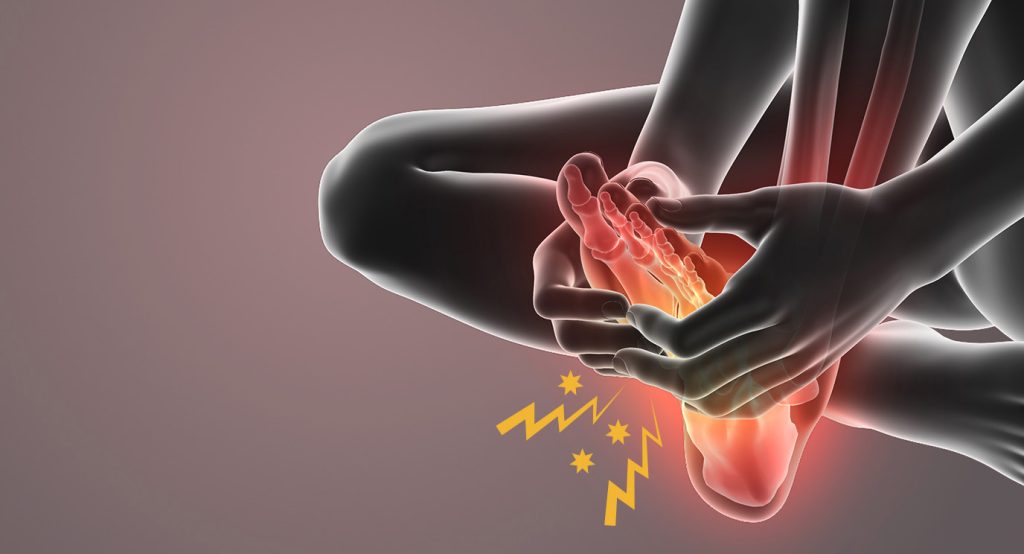Peripheral Neuropathy has become a widespread health issue, but has had a poor record of recovery success in medical treatments. As neuropathic pain is strongly correlated with magnesium deficiency and the associated hyper-inflammatory state, researchers have discovered that supplementary magnesium can directly affect the nerve recovery process to alleviate peripheral neuropathy.
Neuropathic pain includes diabetic neuropathy, postherpetic neuralgia (PHN), cancer-related pain, trigeminal neuralgia, post-amputation pain, polyneuropathy, radiculopathy, and post-stroke pain.

According to a 2020 study review, this condition is caused by, “Any disease or lesion in the somatosensory system that results in the disordered transmission of sensory signals to the spinal cord or brain… When magnesium therapy was administered to patients presenting with low back pain with a neuropathic component, pain intensity reduced and the range of motion of the lumbar spine improved. Neuropathic pain and functional disability following spinal cord injury can improve with magnesium treatment. A case series showed that opioid-resistant cancer-related neuropathic pain is relieved by magnesium.” 1
Peripheral neuropathy is a painful condition that usually occurs in the extremities and results from nerve damage. The symptoms can be triggered by diabetes and metabolic syndrome, acidosis and mitochondrial dysfunction, alcoholism, tumours, infections such as AIDS, as well as traumatic injuries. All these conditions have an inflammatory state in common. Even low magnesium itself can cause inflammation of nerves and peripheral neuropathy.
The first symptoms of peripheral neuropathy are often felt in the toes, with the gradual onset of numbness and tingling, burning pain or a sensation like an electric shock. If the condition escalates it can spread from toes further up the leg. If the motor nerves controlling muscle movement are affected, it may also cause muscle weakness. Spinal cord injury can be another reason for these symptoms. Chronic inflammation leads to nerve damage and Central Sensitization of the nervous system.
Central Sensitization and Hypersensitivity
Hypersensitivity to touch can become so extreme that even a light sheet on the skin can cause pain. “Central sensitization occurs due to the enhancement of neuronal properties in the nociceptive pathways of the central nervous system. It is triggered by repetitive nociceptive afferent inputs and eventually manifests as a prolonged reduction in the pain threshold. Central sensitization leads to pain hypersensitivity, including wind-up or long-term pain potentiation; it causes pain even when peripheral stimuli are not intense and continues to cause pain even after the initiating stimuli have disappeared.” 1
Magnesium as an Anti-Inflammatory With Antinociceptive Effects
Magnesium has long been used as an adjunct in the treatment of migraines and muscle pain conditions. Even though it doesn’t have a direct analgesic effect, it is thought that its control of the calcium channels is the main reason why supplementary magnesium alleviates pain. Since magnesium can regulate calcium entry into cells by antagonizing N-Methyl-D-Aspartate (NMDA) receptors (and thereby restricting calcium influx to cells), many studies have shown promising results in its use as an adjuvant analgesic with antinociceptive effects.
Magnesium supplementation has been shown to have an anti-inflammatory effect, and supports the healing, recovery and protection of nerves to alleviate peripheral neuropathy.
Researchers have suggested that many of the consequences of magnesium deficiency and inflammation as a result of excessive stress may be explained by the release of substance P, which is a neuropeptide that preferably activates tachykinin NK1 receptors.
“Low concentrations of magnesium diminish the magnesium-gated blockade of NMDA receptor channels, which leads to the release of substance P and the calcitonin gene-related peptide from the sensory C fibres. The increased circulating levels of neuropeptides initiate an important ‘neurogenic inflammation’ characterized by raised levels of inflammatory cells, inflammatory cytokines and augmented production of reactive oxygen and nitrogen species.” 2
Magnesium has a protective effect on the central nervous system. In a stressed state magnesium ions stored in cells tend to diminish. This affects the integrity of the cell membrane, so that it becomes, in a sense, ‘looser’, causing the calcium ion channels to open massively. 3 When there is a lot of calcium ion ingress into cells, it leads to overstimulation, cell swelling and apoptosis. Supplementary magnesium helps to block the NMDA receptor via an electric charge, thereby inhibiting the entry of the calcium ions into the cell, and calming down the inflammatory and pain response.
Inflammation Can Damage Nerves, Causing Peripheral Neuropathy:
Magnesium Protects Nerves by Inhibiting Inflammation
The Zhang review concluded that magnesium promotes peripheral nerve repair by inhibiting inflammation. “[Magnesium] has been shown to inhibit activated macrophage-induced inflammation and thus promotes the differentiation of mesenchymal stem cells.” 3 Conversely, “magnesium deficiency leads to significant increases in pro-inflammatory cytokines such as tumour necrosis factor-a, IL-1 and IL-6.”

The peripheral nervous system is made up of Schwann cells, which are neuro-gliocytes that are sensitive to inflammation and consequently suffer apoptosis (cell death). The Schwann cells are extremely important for nerve health, as they not only participate in the formation of the myelin sheath, which protects the nerves, but they also maintain the growth environment of the nerve axons through the rapid proliferation, division and secretion of various protein molecules after peripheral nerve injury.
The Schwann cells secrete large amounts of endogenous neurotropic factor (NTF), including nerve growth factor (NGF) which plays a promoting role in the repair and regeneration of injured peripheral nerves. It has been reported that NGF acts on the growth of axon fibres rather than neurons themselves.
Appropriate concentrations of magnesium ions in the tissue microenvironment can promote Schwann cell proliferation, as well as their NGF secretion to repair nerves.
Transdermal Magnesium for the Treatment of Peripheral Neuropathy (STUDY)
Patients who had Chronic Kidney Disease had a significant improvement in their peripheral neuropathy during a 12 week study spraying on their limbs a solution of magnesium chloride daily. The study concluded that, “Transdermal magnesium may be beneficial in reducing frequency and severity of peripheral neuropathic symptoms.” 4
It should be noted that this study found no significant difference in the plasma (blood) levels of magnesium, despite the significant results to alleviate muscle and nerve pain. This is because magnesium can be absorbed transcellularly (cell to cell) and is not reliant on passing through the body via the blood stream first. 99% of the body’s magnesium reserves are stored in the tissue cells of muscle and bone, and only one percent is in the blood. The tissue cells will often sacrifice their magnesium stores to keep the blood levels in the normal range, so blood tests are not accurate indicators of total body magnesium.
CUSTOMER REVIEW – Magnesium Cream and Magnesium Oil Spritz
“I have so far purchased three (3) tubs of your [Elektra] Magnesium Cream 300mg Sensory Gold. I heard about it being good for painful conditions. My problem is Peripheral Neuropathy (Idiopathic) and I have been using the cream on and under my feet and legs for some time [because] the pain and discomfort is worse at night in bed. Trying to massage can be difficult, but I manage to cream under and over my feet, under my curled toes and my legs up to my knees. Following that I put on soft socks and then get to sleep comfortably. I have been recommending this product to others who have this disease – and also to my doctors and podiatrist. Another method I have is to use Magnesium Oil [Spritz]. Both methods create some peace from this awful condition.” Dorothy Hughes
“The proof is in the pudding,” as the saying goes. You can’t use too much magnesium transdermally as magnesium chloride salt, because the body is self-regulating when it absorbs it from the epidermis (as long as there are no synthetic chemical barrier penetrators present). The body will absorb what it needs in its own time. Note that the presence of fats (lipids), as in Magnesium Cream or Lotion, enhances the absorption of magnesium ions into the reservoir of the skin because the skin is lipophilic. It also improves the condition of the skin with an anti-ageing effect. So, you can be generous with your magnesium self-care every day and feel the difference. If you want to know how much you may be getting in magnesium supplementation, refer to the Elektra Magnesium dose guide. More information about neuropathic pain is in another article (click here).





By Sandy Sanderson © 2023
References:
(1) Shin, H.-J.; Na, H.-S.; Do, S.-H. Magnesium and Pain. Nutrients 2020, 12 (8), 2184. https://doi.org/10.3390/nu12082184.
(2) Na, H.-S.; Ryu, J.-H.; Do, S.-H. The Role of Magnesium in Pain. In Magnesium in the Central Nervous System; Vink, R., Nechifor, M., Eds.; University of Adelaide Press: Adelaide (AU), 2011.
(3) Zhang, J.; Zhang, B.; Zhang, J.; Lin, W.; Zhang, S. Magnesium Promotes the Regeneration of the Peripheral Nerve. Front Cell Dev Biol 2021, 9, 717854. https://doi.org/10.3389/fcell.2021.717854.
(4) Athavale, A.; Miles, N.; Pais, R.; Snelling, P.; Chadban, S. J. Transdermal Magnesium for the Treatment of Peripheral Neuropathy in Chronic Kidney Disease: A Single-Arm, Open-Label Pilot Study. J Palliat Med 2023. https://doi.org/10.1089/jpm.2023.0229.

